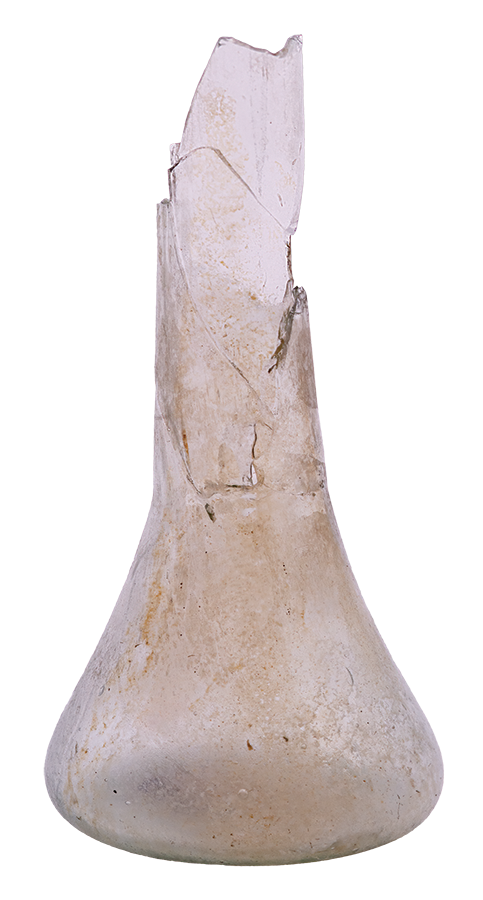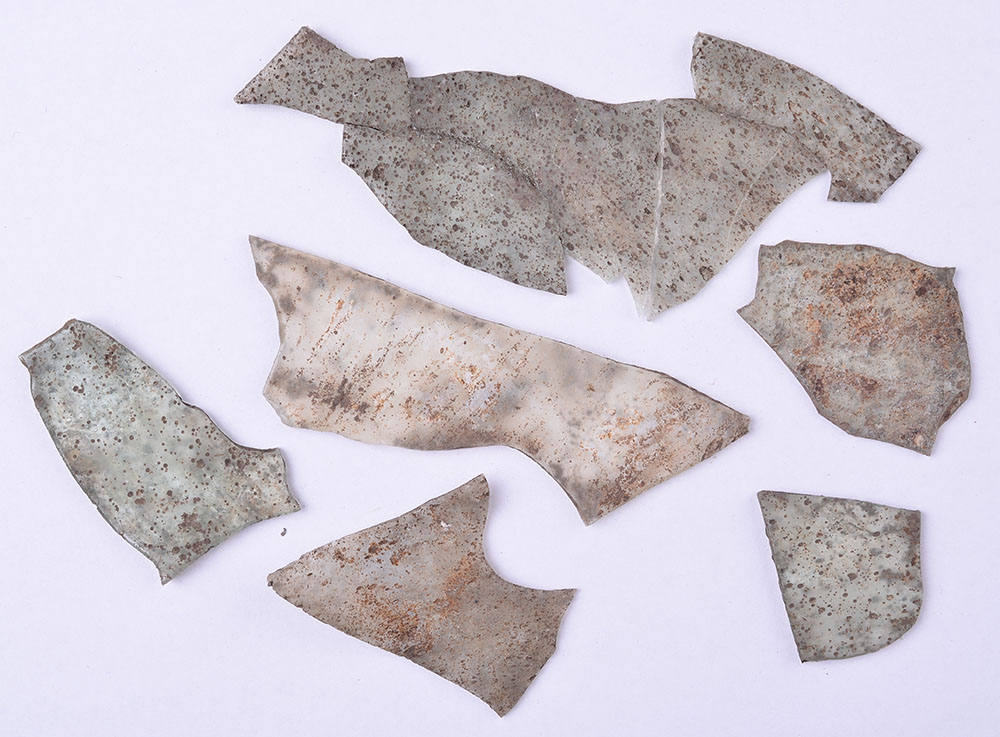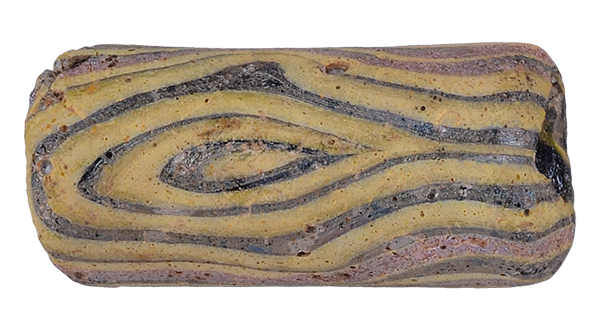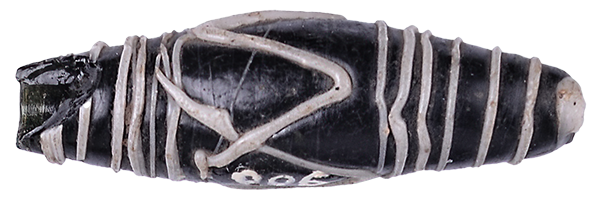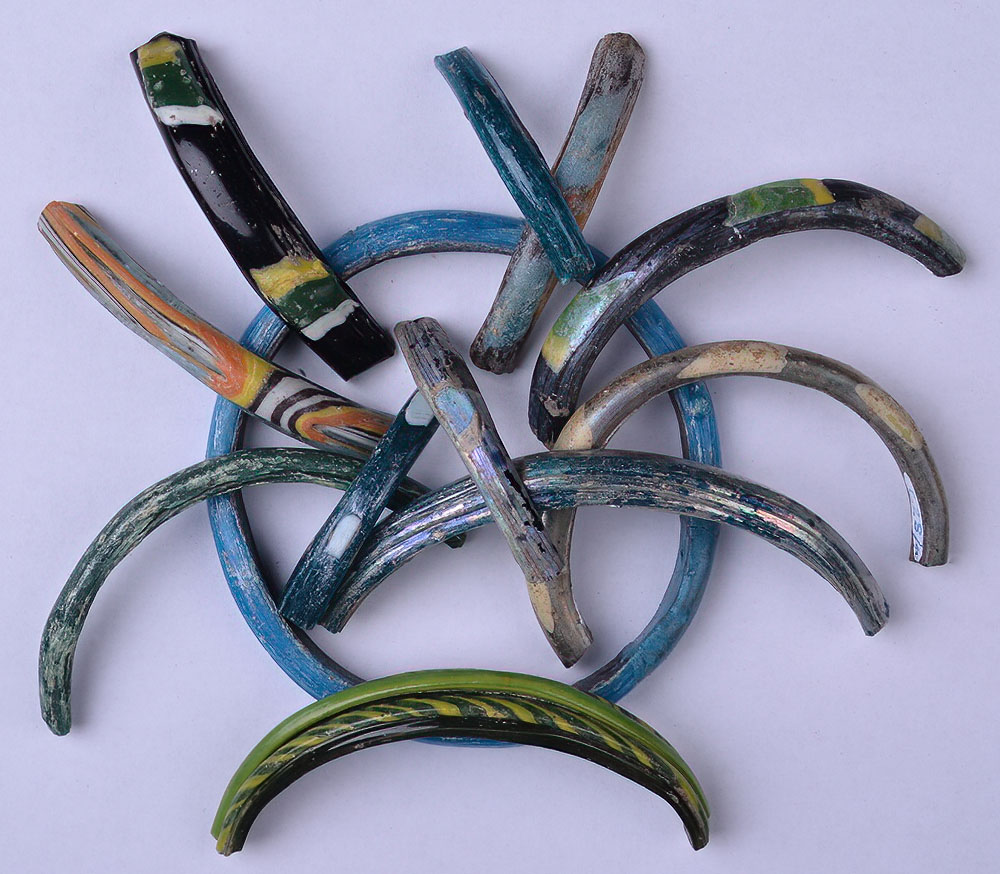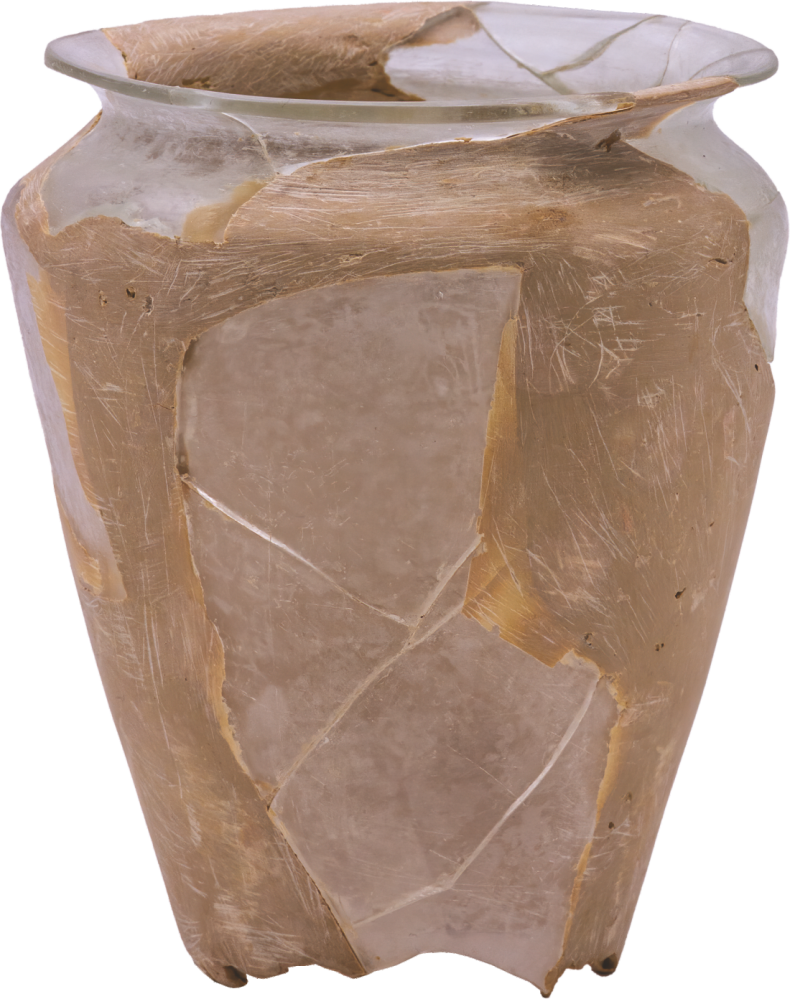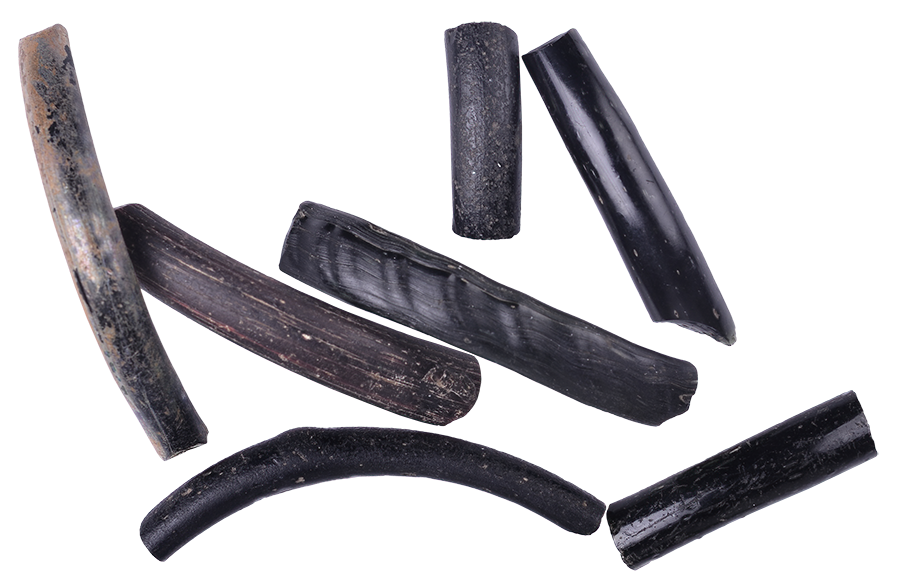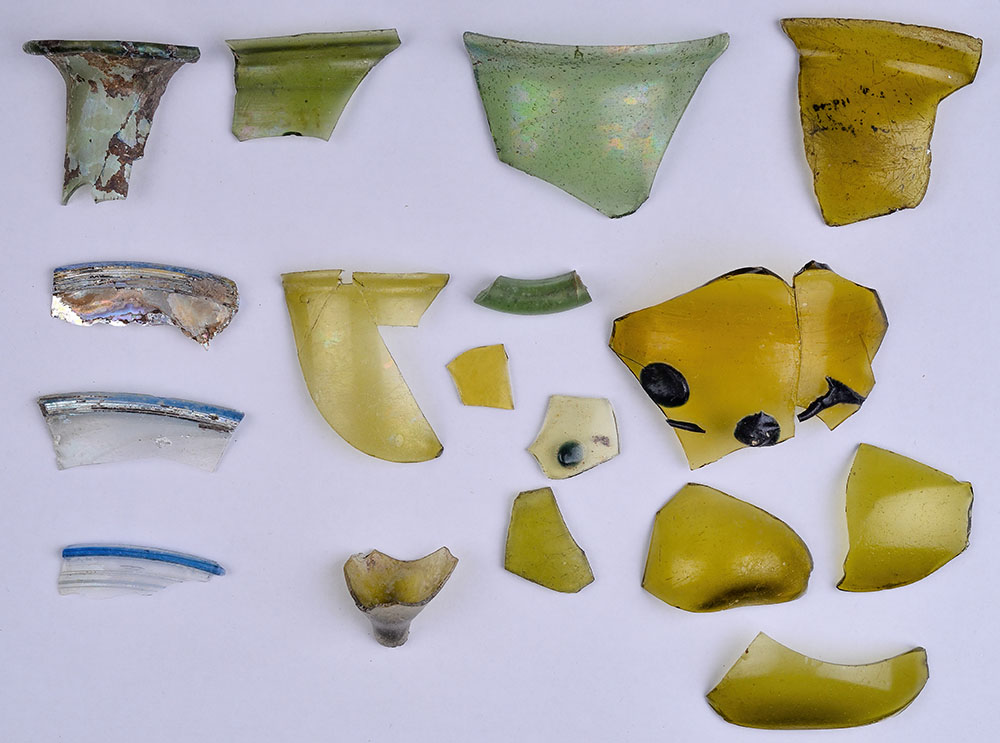Virtual Gallery of the Regional Museum Jagodina
Author of the exhibition: Smiljana Dodić
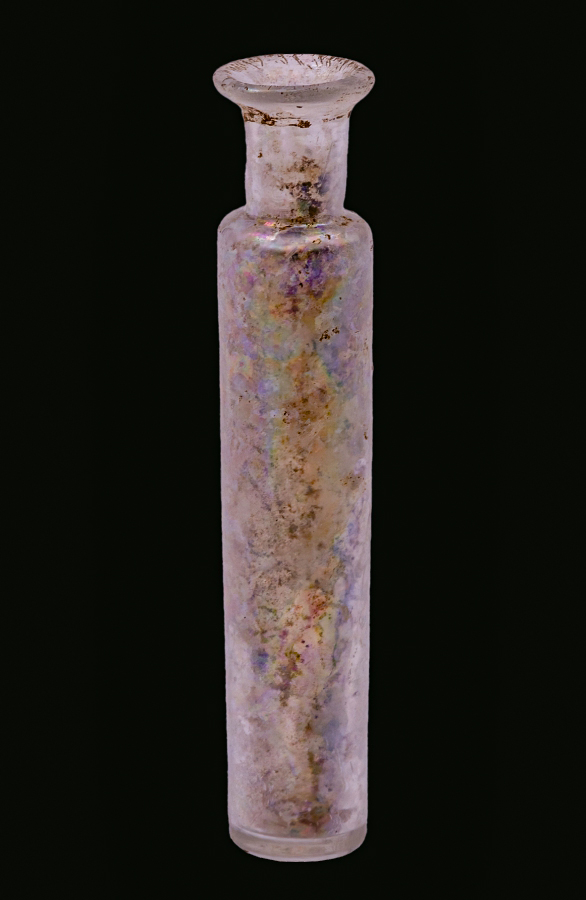
Glass items in the archeological collections of the Regional Museum
The archeological collections of the Regional museum contain specimens of glass objects since Roman to post – medieval period. Despite small number of items, this kind of artifacts provides important data on glass production and trade in this region from the beginning of new era to modern times. The earliest items in our collections are dated to the late Roman period, such as fragments of glass vessels and window panes found in hilltop fortresses in Vojska and Staro selo near Jagodina, a fragmented balsamarium from Horreum Margi (Ćuprija), and few beads made of opaque glass.
The medieval glass objects in our collections were mostly found during the systematic archaeological researches of the Resava (Manasija) monastery. Among the fragments of glass vessels discovered in this monastery complex built by despot Stefan Lazarević, one should mention reconstructed candle and fragmented bowl made of casted glass, and a cosmetic bottle too. Numerous, mostly fragmented oculi, the multicolored circular window panes, but also one entirely preserved oculus made of colorless cast glass, were found in this monastery too. This kind of multicolored window glass was probably imported from Venice and Dubrovnik.
Finally, the collection contains numerous specimens of medieval glass jewelry, especially the opaque glass bangles. This kind of jewelry was widely spread in the Central and Eastern Balkans during the 12th century, and its origins date back to the very beginnings of Egyptian glassmaking in the middle of the 2nd millennium BC. Except in the eastern areas of the Mediterranean, glass bangles have appeared in Europe since the protohistoric La Tène culture and spread thorough the Roman world at the end of the Republican period. Glass bangles were commonly spread in this part of Byzantine world during the 12th century, but they disappeared from our territory after the withdrawal of Byzantium until the Turkish conquests, when they numerously reappeared in this region in the end of the 15th to the 17th century. The earliest example of this type of jewelry in the collection comes from an early Byzantine fortification in Vojska, and several accidental finds made of dark green and black opaque glass date back to the 12th century. Numerous late medieval bangles from the Resava (Manasija) monastery differ from earlier items by distinct splendor, as a result of technology changes and modernizing. The appearance of this kind of jewelry correlates to the fall of the Manasija Monastery under Ottomans which is testified by the oriental origin of this type of bangles and the tradition of their production in the eastern Mediterranean.
Glassmaking through history
“Take 60 parts of sand, 180 parts of seaweed ash, 5 parts of chalk or crumbled shells, heat everything well, then cool it and so you will get glass …” – says a record from the library of the Assyrian king Ashurbanipal (r. 669 – c. 631 BC). This text from the mid 7th century BC, engraved in cuneiform, is the oldest known recipe for making glass.
Even 2500 years later, this recipe has not changed much: quartz sand, soda, and limestone remained the basic ingredients for glass production. However, the history of glass goes back much deeper than its first mentioning.
From Babylon and Egypt to modern Europe
The earliest form of glass known to man was natural, volcanic glass – obsidian, used in Neolithic cultures for producing fine blades more than 8000 years ago. On the other hand, it is believed that the discovery of the oldest artificial substance – synthetic glass came about by accident during some metallurgy process. One legend, recorded in The Natural History by the Roman author Pliny the Elder, tells that Phoenician merchants used soda instead of stone to prepare lunch on the sandy banks of the Belus River in modern northern Israel; exposed to fire, sand and soda merged into a liquid glass mass and thus the first, soft glass was formed.
However, archeological finds from Mesopotamia and Egypt testify to glassmaking long before the Phoenician trade flourished. In 3500 – 3000 BC glass appeared as glaze – enamel covering of ceramic beads while the first jewelry made entirely of glass was created around 2500 BC. The first glass vessels appeared in Egypt during the reign of Pharaoh Thutmose III (1479 – 1425). Numerous finds from the necropolises of Egypt, Babylon, Assyria, Syria and Phoenicia, as well as the sites of the Cretan – Mycenaean civilization, refer to rising and flourishing of glassmaking. In the middle of the 1st millennium BC, trading enabled Egyptian glass and glassmaking technology to reach distant areas of the ancient world, so even the European prehistoric Iron Age cultures started glassmaking of jewelry items – beads, bangles and fibula ornaments.
From Egypt, glass production was transferred to numerous workshops on the Syrian-Levantine coast. About 100 B.C. a revolutionary technique of glassblowing was discovered and soon it was transferred and perfected to mastery in Italic workshops at the beginning of the reign of Octavian Augustus. As glassmaking became more commercial, glass was getting cheaper and widely available. The whole procedure of rough processing and production of glass raw material was performed in workshops near the deposits of its basic ingredients – soda (Egypt) and quality sand (Levant – Syria), while the production of glass items was performed in Italic workshops. At the end of the 1st century AD, recycling / re-casting of broken glass was discovered. At the same time, the process of de-colorization of glass has been mastered, and it was made either colorless or natural bluish-green, in accordance with the tastes of new markets.
In later epochs, glassmaking spread to the western provinces of the Roman Empire, to Spain, Gaul, Germany, as well as the Balkan provinces, where one of the leading glass centers was Sirmium. In addition to the increased use of glass objects on the territory of Serbia since the mid 3rd century, in unstable political circumstances during the 4th century, there was a sharp boom in glassmaking by the local workshops. Despite the quantity, the quality of glass produced in local workshops started to decline, so glass became blurred, with bubbly structure, while in the late antiquity it would be mostly yellowish-greenish.
The tradition of Roman glassmaking in the later centuries continued to be practiced in Byzantium, but since the 13th century on the Venetian masters from the island of Murano became the leading glassmakers in medieval Europe. Under the influence of Venice, Dubrovnik started its own glass production in the 14th century, whereby this kind of luxury products would reach medieval Serbia too. Unlike soft, sodium glass of the Murano workshops, whose production reached its peak in the 16th -17th century, Czech and German craftsmen began making harder glass based on potassium. Lead, heavy, “crystal” glass discovered in England in the 17th century, and decorated with polished motifs, suppressed the Venetian glassmaking of the Murano masters taking over primacy on the European market.
The process of making glass
The technological process of making Roman glass began with the mixing of silicate (quartz sand) and alkaline substances necessary for its melting – soda or potash, in a scale of 9:3. At the beginning of the process, the mixture was heated in a ceramic vessel which enabled removing impurities and foam. The obtained purified liquid glass was cooled and then crushed, so its highest quality parts went for further processing in a glass furnace, where they were melted at a temperature of up to 1300 degrees. Liquid glass obtained on this way was shaped by one of the glass techniques that have been developed and changed but also preserved to this day. The oldest technique, called “Sand core”, used for production of cosmetic bottles from the 15th century BC to the 2nd century AD., was based on coating or wrapping an earth or sand model with glass mass, similar to the technique used to this day to make beads. The technique of casting and mold pressing, already known in the Cretan – Mycenaean civilization, was used to make pieces of jewelry, utensils, as well as window panes. Discovery of the glass pipe at the end of the old era enabled shaping of objects by blowing air into hot glass mass, and in addition to the technique of free blowing, the technique of mold blowing was also used.
Using these techniques, glass objects from the funds of the archeological collections of the Regional Museum in Jagodina were also made.



